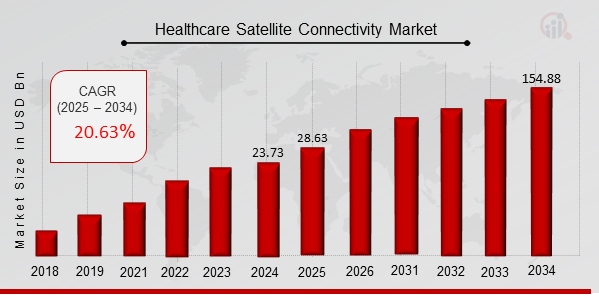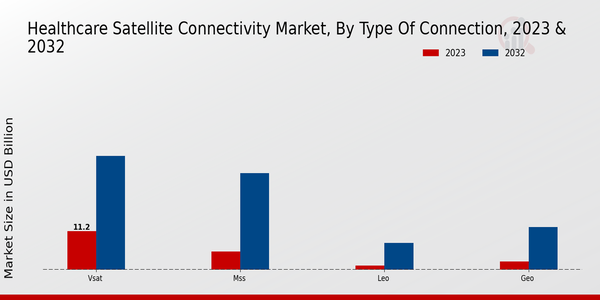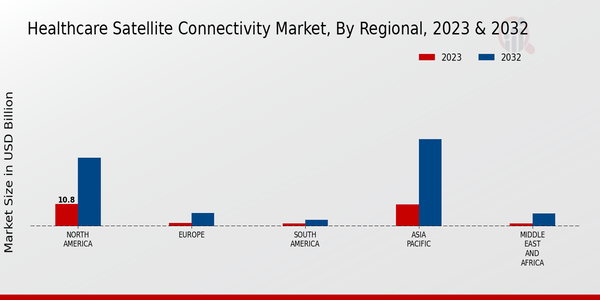Healthcare Satellite Connectivity Market Overview
As per MRFR analysis, the Healthcare Satellite Connectivity Market Size was estimated at 23.73 (USD Billion) in 2024. The Healthcare Satellite Connectivity Market Industry is expected to grow from 28.63 (USD Billion) in 2025 to 154.88 (USD Billion) till 2034, at a CAGR (growth rate) is expected to be around 20.63% during the forecast period (2025 - 2034).
Key Healthcare Satellite Connectivity Market Trends Highlighted
The Healthcare Satellite Connectivity market is rapidly evolving, with numerous key market drivers shaping its growth. One significant driver is the increasing demand for telemedicine services, particularly in remote areas with limited access to healthcare facilities.
This trend has been accelerated by the COVID-19 pandemic, which has highlighted the importance of remote healthcare solutions.
Additionally, advancements in satellite technology, such as the development of high-throughput satellites and low-earth orbit constellations, are enabling faster and more reliable connectivity, making satellite-based healthcare services more feasible.
Recent trends in the Healthcare Satellite Connectivity market include the adoption of cloud-based healthcare platforms, the integration of artificial intelligence (AI) and machine learning (ML) to analyze patient data and the increasing use of mobile health (mHealth) applications.
These technologies are enhancing the efficiency and accessibility of healthcare services delivered via satellite connectivity. Furthermore, the growing emphasis on personalized healthcare, coupled with the need for real-time monitoring and data sharing, is creating opportunities for satellite connectivity in the healthcare industry.
 Source: Primary Research, Secondary Research, MRFR Database and Analyst Review
Healthcare Satellite Connectivity Market Drivers
Source: Primary Research, Secondary Research, MRFR Database and Analyst Review
Healthcare Satellite Connectivity Market Drivers
Rising Demand for Telemedicine and Remote Patient Monitoring
The increasing demand for telemedicine and remote patient monitoring is a major driver of growth in the Healthcare Satellite Connectivity Market Industry. As the healthcare industry moves towards value-based care models, there is a growing need for efficient and cost-effective ways to deliver care to patients in remote or underserved areas.
Satellite connectivity plays a critical role in enabling telemedicine and remote patient monitoring by providing a reliable and secure connection between healthcare providers and patients.
Satellite connectivity allows healthcare providers to conduct virtual consultations, monitor patient vital signs remotely, and provide timely interventions. This driver is expected to continue to fuel the growth of the healthcare satellite connectivity market in the coming years.
Government Initiatives and Support
Government initiatives and support are another key driver of growth in the Healthcare Satellite Connectivity Market Industry. Governments around the world are recognizing the importance of satellite connectivity in improving healthcare access and outcomes.
They are implementing various initiatives to promote the adoption of satellite connectivity in healthcare, including funding programs, tax incentives, and regulatory reforms.
For example, the Indian government has launched the National Telemedicine and e-Health Network, which aims to connect rural and remote areas with telemedicine services via satellite connectivity.
This type of government support is expected to further accelerate the growth of the healthcare satellite connectivity market.
Advancements in Satellite Technology
Advancements in satellite technology are also driving the growth of the Healthcare Satellite Connectivity Market Industry. The development of new satellite technologies, such as high-throughput satellites (HTS) and low-earth orbit (LEO) satellites, is enabling the delivery of faster, more reliable, and more affordable satellite connectivity.
HTS satellites provide increased bandwidth capacity, while LEO satellites offer lower latency and improved coverage.
These advancements are making satellite connectivity more accessible and attractive for healthcare applications. Additionally, the development of new satellite constellations, such as OneWeb and SpaceX's Starlink, is expected to further expand the reach and capabilities of satellite connectivity, which will benefit the healthcare industry.
Healthcare Satellite Connectivity Market Segment Insights:
Healthcare Satellite Connectivity Market Type of Connection Insights
The Healthcare Satellite Connectivity Market segmentation by type of connection comprises VSAT (Very Small Aperture Terminal), MSS (Mobile Satellite Service), LEO (Low Earth Orbit), and GEO (Geostationary Orbit). In 2023, the VSAT segment held the largest market share due to its cost-effectiveness and wide coverage.
However, the LEO segment is expected to witness the highest growth rate during the forecast period owing to its low latency and high bandwidth capabilities. VSAT is a cost-effective solution for providing satellite connectivity to remote areas.
It is widely used in healthcare applications such as telemedicine, remote patient monitoring, and disaster response. MSS is another popular type of satellite connection used in healthcare. It is typically used for mobile applications such as ambulance communications and patient tracking.
LEO and GEO are newer types of satellite connections that offer significant advantages over traditional satellite technologies. LEO satellites orbit the Earth at a lower altitude than GEO satellites, which results in lower latency and higher bandwidth.
The growth of the market is attributed to the increasing demand for satellite connectivity in healthcare applications, such as telemedicine, remote patient monitoring, and disaster response.
The Healthcare Satellite Connectivity Market is a highly competitive market with a number of key players. Some of the major players in the market include Intelsat, SES, Inmarsat, Iridium, and Thuraya. These companies offer a wide range of satellite connectivity solutions for healthcare applications.
 Source: Primary Research, Secondary Research, MRFR Database and Analyst Review
Healthcare Satellite Connectivity Market Application Insights
Source: Primary Research, Secondary Research, MRFR Database and Analyst Review
Healthcare Satellite Connectivity Market Application Insights
The Healthcare Satellite Connectivity Market is segmented by Application into Telemedicine, Remote Patient Monitoring, Disaster Response and Emergency Communication, Asset Tracking and Supply Chain Management, and Tele-education.
Among these, Telemedicine held the largest market share in 2023, owing to the increasing adoption of telemedicine services for remote consultations, patient monitoring, and chronic disease management. Remote Patient Monitoring is another significant segment, driven by the growing demand for remote patient monitoring solutions to improve patient outcomes and reduce healthcare costs.
Disaster Response and Emergency Communication is also expected to witness significant growth, as satellite connectivity plays a crucial role in providing communication and data transmission during natural disasters or emergencies.
Asset Tracking and Supply Chain Management and Tele-education are other emerging segments, with potential growth opportunities in healthcare logistics and remote education, respectively.
Healthcare Satellite Connectivity Market End User Insights
The End User segment of the Healthcare Satellite Connectivity Market is projected to exhibit significant growth over the forecast period. Hospitals and Clinics are expected to account for a major share of the market due to the increasing demand for reliable and high-speed connectivity for patient care, remote patient monitoring, and telemedicine services.
Government Agencies are also expected to contribute significantly to the market growth as they invest in satellite connectivity to improve healthcare access in remote and underserved areas.
Moreover, Non-profit Organizations are playing a crucial role in providing healthcare services in developing countries, and satellite connectivity enables them to reach remote communities and provide essential medical care.
Medical Transportation Providers are also expected to drive market growth, as they rely on satellite connectivity to ensure reliable communication and data transmission during medical evacuations and patient transport.
Patients and Consumers are increasingly adopting satellite connectivity for personal health monitoring, remote consultations, and access to healthcare information, which is expected to further fuel market growth in the coming years.
Healthcare Satellite Connectivity Market Service Type Insights
The Service Type segment is a crucial aspect of the Healthcare Satellite Connectivity Market, offering diverse services to cater to the specific needs of healthcare providers. Among the key service types, Bandwidth-on-Demand stands out as a highly sought-after solution.
It provides flexible and scalable bandwidth, enabling healthcare organizations to meet fluctuating demands and ensure seamless connectivity for critical applications. In 2023, the Bandwidth-on-Demand segment held a significant share of the Healthcare Satellite Connectivity Market revenue, and its growth trajectory is expected to remain strong in the coming years.
Managed Services, another prominent service type, offers comprehensive support and maintenance for satellite connectivity infrastructure. By outsourcing these tasks to specialized providers, healthcare organizations can focus on their core competencies while ensuring optimal network performance and security.
The growing adoption of managed services is expected to drive market growth over the forecast period. Professional Services, including consulting, design, and implementation, play a vital role in the successful deployment and optimization of satellite connectivity solutions.
Healthcare organizations seek expertise in planning, integrating, and managing complex satellite networks, leading to increased demand for professional services. This segment is anticipated to witness steady growth in the coming years.
Equipment Sales, comprising satellite terminals, modems, and other hardware components, represent a fundamental aspect of the Healthcare Satellite Connectivity Market. The growing adoption of satellite-based healthcare applications, coupled with advancements in satellite technology, is expected to fuel demand for equipment sales.
Leading manufacturers are investing in research and development to enhance the capabilities and efficiency of satellite equipment, driving market growth.
Healthcare Satellite Connectivity Market Frequency Band Insights
The Healthcare Satellite Connectivity Market segmentation by Frequency Band includes Ku-band, Ka-band, C-band, and X-band. Among these, the Ku-band segment is expected to dominate the market in the coming years, owing to its wide bandwidth and high data rates.
The Ka-band segment is also expected to witness significant growth, due to its ability to provide higher bandwidth and lower latency. In 2023, the Ku-band segment generated a revenue of approximately USD 4.2 billion, and the Ka-band segment generated a revenue of approximately USD 1.8 billion.
The C-band and X-band segments are expected to account for a smaller share of the market, but they are also expected to witness stable growth over the forecast period.
Healthcare Satellite Connectivity Market Regional Insights
The Healthcare Satellite Connectivity Market is expected to witness remarkable growth in the coming years, driven by factors such as increasing demand for telemedicine, remote patient monitoring, and disaster response communications.
Regionally, North America is projected to dominate the market throughout the forecast period, owing to the presence of well-established healthcare infrastructure, high adoption of advanced technologies, and favorable government initiatives. Europe is anticipated to follow closely, with a growing emphasis on digital health and telemedicine initiatives.
APAC is expected to exhibit significant growth potential due to the rising population, increasing disposable income, and expanding healthcare access in emerging economies. South America and MEA are expected to experience steady growth as these regions continue to invest in healthcare infrastructure and connectivity solutions.
 Source: Primary Research, Secondary Research, MRFR Database and Analyst Review
Healthcare Satellite Connectivity Market Key Players and Competitive Insights:
Source: Primary Research, Secondary Research, MRFR Database and Analyst Review
Healthcare Satellite Connectivity Market Key Players and Competitive Insights:
Major players in the Healthcare Satellite Connectivity Market industry are continuously focusing on expanding their offerings and strengthening their market presence. Leading Healthcare Satellite Connectivity Market players are adopting various strategies such as new product launches, collaborations, and acquisitions to gain a competitive edge.
The Healthcare Satellite Connectivity Market development of innovative technologies such as low earth orbit (LEO) satellites is expected to further intensify competition in the market.
One of the leading players in the Healthcare Satellite Connectivity Market is Inmarsat, which offers a wide range of satellite connectivity solutions for healthcare applications. The company has a strong global presence and a track record of providing reliable and secure satellite connectivity for critical healthcare services.
Inmarsat is focused on expanding its reach in emerging markets and investing in new technologies to meet the evolving needs of the healthcare industry.
Another major player in the Healthcare Satellite Connectivity Market is Intelsat, which provides a global network of satellites and connectivity services for healthcare providers. The company offers a range of solutions, including telemedicine, remote patient monitoring, and disaster response communications.
Intelsat is focused on providing cost-effective and reliable connectivity for healthcare applications and has a strong track record of supporting critical healthcare missions.
Key Companies in the Healthcare Satellite Connectivity Market Include:
- Inmarsat
- EchoStar
- SES S.A.
- Eutelsat Communications
- Telesat Canada
- Iridium Communications Inc.
- Avanti Communications Group plc
- Gilat Satellite Networks
- Viasat, Inc.
- Thuraya Telecommunications Company
- Globalstar, Inc
- Hispasat
- Intelsat S.A.
- Chunghwa Telecom Co., Ltd. (CHT)
Healthcare Satellite Connectivity Market Industry Developments
The increasing demand for telemedicine, remote patient monitoring, and other healthcare applications that rely on reliable and high-speed internet connectivity is driving the growth of the market. Key players in the market include Intelsat, Inmarsat, SES, and Viasat.
Recent developments in the market include the launch of new satellites with increased bandwidth and coverage, as well as the development of new technologies such as 5G and low-earth orbit (LEO) satellites.
Healthcare Satellite Connectivity Market Segmentation Insights
Healthcare Satellite Connectivity Market Type of Connection Outlook
- VSAT (Very Small Aperture Terminal)
- MSS (Mobile Satellite Service)
- LEO (Low Earth Orbit)
- GEO (Geostationary Orbit)
Healthcare Satellite Connectivity Market Application Outlook
- Telemedicine
- Remote Patient Monitoring
- Disaster Response and Emergency Communication
- Asset Tracking and Supply Chain Management
- Tele-education
Healthcare Satellite Connectivity Market End User Outlook
- Hospitals and Clinics
- Government Agencies
- Non-profit Organizations
- Medical Transportation Providers
- Patients and Consumers
Healthcare Satellite Connectivity Market Service Type Outlook
- Bandwidth-on-Demand
- Managed Services
- Professional Services
- Equipment Sales
Healthcare Satellite Connectivity Market Frequency Band Outlook
- Ku-band
- Ka-band
- C-band
- X-band
Healthcare Satellite Connectivity Market Regional Outlook
- North America
- Europe
- South America
- Asia Pacific
- Middle East and Africa
| Report Attribute/Metric |
Details |
|
Market Size 2024
|
23.73 (USD Billion)
|
|
Market Size 2025
|
28.63 (USD Billion)
|
|
Market Size 2034
|
154.88 (USD Billion)
|
|
Compound Annual Growth Rate (CAGR)
|
20.63 % (2025 - 2034)
|
|
Report Coverage
|
Revenue Forecast, Competitive Landscape, Growth Factors, and Trends
|
|
Base Year
|
2024
|
|
Market Forecast Period
|
2025 - 2034
|
|
Historical Data
|
2020 - 2024
|
| Market Forecast Units |
USD Billion |
| Key Companies Profiled |
Inmarsat, EchoStar, SES S.A., Eutelsat Communications, Telesat Canada, Iridium Communications Inc., Avanti Communications Group plc, Gilat Satellite Networks, Viasat, Inc., Thuraya Telecommunications Company, Globalstar, Inc, Hispasat, Intelsat S.A., Chunghwa Telecom Co., Ltd. (CHT) |
| Segments Covered |
Type of Connection, Application, End User, Service Type, Frequency Band, Regional |
| Key Market Opportunities |
Telemedicine Expansion Remote Patient Monitoring Growth Disaster Response Support Rural Healthcare Access Connectivity for Medical Devices |
| Key Market Dynamics |
Rising demand for remote healthcare Government initiatives Technological advancements Increasing use of telemedicine Expansion of coverage in rural areas |
| Countries Covered |
North America, Europe, APAC, South America, MEA |
Frequently Asked Questions (FAQ) :
The Healthcare Satellite Connectivity Market is expected to reach USD 154.88 billion by 2034, growing at a CAGR of 20.63% from 2025 to 2034.
North America is expected to hold the largest share of the Healthcare Satellite Connectivity Market due to the presence of well-established healthcare infrastructure and increasing adoption of telemedicine services.
The telemedicine segment is expected to account for the highest revenue share in the Healthcare Satellite Connectivity Market due to the growing demand for remote healthcare services.
Some of the key competitors in the Healthcare Satellite Connectivity Market include Intelsat, SES, Inmarsat, and Iridium Communications.
The key growth drivers for the Healthcare Satellite Connectivity Market include increasing demand for telemedicine services, growing adoption of IoT devices in healthcare, and government initiatives to improve healthcare access in remote areas.
The key challenges faced by the Healthcare Satellite Connectivity Market include the high cost of satellite equipment, limited bandwidth availability, and regulatory barriers.
The key trends shaping the Healthcare Satellite Connectivity Market include the integration of AI and ML technologies, the development of low-earth orbit (LEO) satellites, and the increasing use of satellite connectivity for remote patient monitoring.
5G technology is expected to have a positive impact on the Healthcare Satellite Connectivity Market by enabling faster and more reliable data transmission, which will support the growth of telemedicine and other healthcare applications.
The Healthcare Satellite Connectivity Market is expected to continue to grow rapidly in the next five years, driven by the increasing demand for telemedicine and other healthcare applications.
The key opportunities for growth in the Healthcare Satellite Connectivity Market include the development of new satellite technologies, the expansion of telemedicine services into new markets, and the increasing use of satellite connectivity for remote patient monitoring.

















